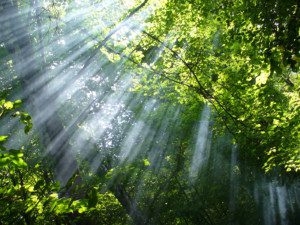
by Maria Ede-Weaving
We make plans in life but putting things in place for the eventuality of our own deaths leaves a good few of us a little squeamish. It can feel a little like tempting fate.
Six years ago I sat with my father in the funeral directors as he chose, booked and paid for the funeral he desired. It was a peculiar experience helping him to select his coffin and the manner of his departure. Dad appeared completely unperturbed by it all, his usual jovial self, whilst I endured an uncomfortable hour, fighting back a growing sense of panic that the day I dreaded would come; on some unknowable date, I would be back in that room, without him by my side, putting his plans into practice.
Since my sister’s death, dad knew that he wanted a woodland burial. On a beautiful August day, two years previously, we had laid my sister to rest in a woodland site on the South Downs. We followed her willow coffin – flowers woven into its lattice-work – through the beech and hazel. Shafts of sunlight penetrated the canopy of trees, and as we walked amongst the wild marjoram that covered the grave site, its spicy scent rose like incense. As my sister was given back to the earth, a lone dragonfly circled us in agitated spirals. It was a moving and extraordinary committal, the peace and beauty of that place – a burial so removed from the Victorian residue of gothic death that imbues so many modern funerals – made those last painful moments a good deal easier to bear.
The woodland or natural burial movement is growing. The burials must be ecologically sound, putting back into the earth only natural, biodegradable materials – coffins, shrouds, grave goods and wreaths must all comply with this eco standard. This care and thought seems to lend the whole process a sacredness that can sometimes be lacking in the commercial world of the modern funeral industry.
As the plots are filled, the woodlands grow, trees planted in remembrance of those buried there. This coming together of the planting of trees and the committal of loved ones, strikes at something deep within us. It is no accident that we name our ancestral line ‘The Family Tree’; trees, like families, have roots and branches, a holistic system of growth and renewal that echoes the human experience. Our ancestors root us in history; without them we would not be; we draw from their lives, now hidden from view and essentially unknowable but still influencing us in ways that we might only guess at.
The seasonal round of deciduous trees speak to us of our own life cycles; we too have times of budding, of flowering and bearing fruit. We also must shed all that is outworn, letting fall that which no longer serves us, allowing it to break down into an emotional mulch of experience that will nourish our present and help sustain our future. The tree of life tells us that even with our passing, life goes on, that we are intimately connected to all that have lived before us and all that will come after. The woodland system reflects our own sense of belonging; we stand as individual trees yet part of a wider community, each life form helping to support the health of the whole.
On top of all this, the peace and beauty of these places can be enormously helpful when we are faced with the loss of those we love. There is something eternal and timeless about forests; it is easier to still ourselves and connect to our deeper emotional self when we are in them. This process is so important when we grieve; the woodland becomes a place of sanctuary, a verdant holding that we might feel what we need to feel and gently process our loss.
Less than a month ago, as the bluebells and cowslips flourished and the vivid green of spring leaves brought renewed life to the woodlands, my father unexpectedly passed away. The moment I had dreaded arrived, and for the second time I found myself walking that path into the woods.
This time, I followed a cardboard coffin, topped with a natural wreath in the shape of a heart, woven with cypress, hazel and daisies, made by my own family. The birds sang and the sunlight streamed through, tinged with the otherworldly green of new leaves. As we stood around the grave, that familiar peace descended and despite the pain of the moment, I could feel my dad’s approval.
Dad loved the cycles of nature; he loved the woods and downland of his home. He strongly felt himself a part of the natural round and as he was lowered into the chalk – as the earth tenderly held him – it seemed to me that he was home. And as much as the physical absence of those we love can be so difficult to bear, they are never truly lost. In death, as in life, we continue to be a part of this extraordinary mystery. It is our form not our essence that changes when we die. We never stop being a part of everything. I will feel my dad in the warmth of the sun and the peace of the woodland because there is essentially a part of us all that eternally resides there. Like the woodlands, our individual parts join to make a magical whole; the boundaries and labels that we assume in life quickly dissolve. Maria’s blog.